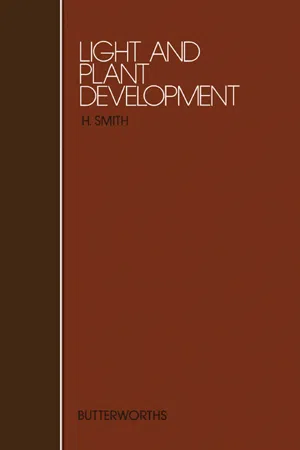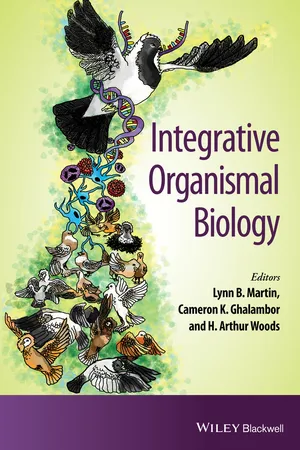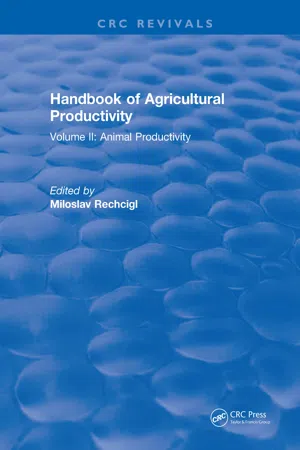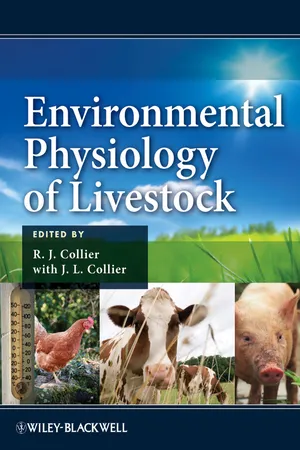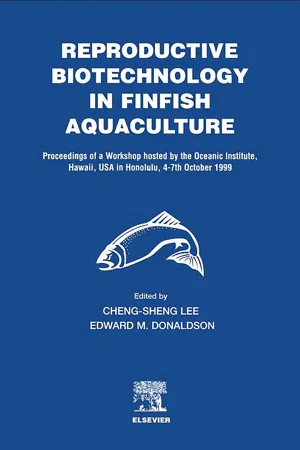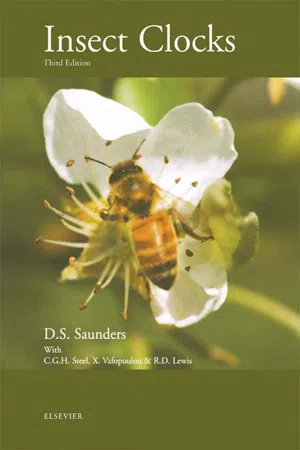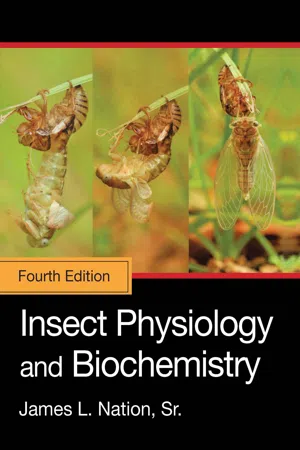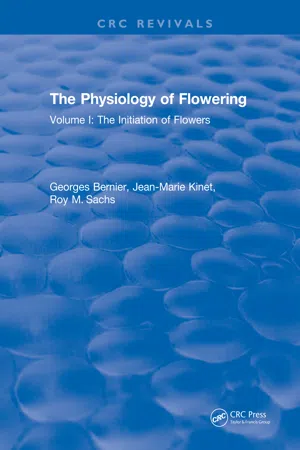Biological Sciences
Photoperiodism
Photoperiodism is the response of an organism to the length of day and night. It influences various biological processes such as flowering in plants, migration in birds, and reproduction in mammals. Photoperiodism is regulated by the perception of light and dark periods, which triggers specific physiological and behavioral changes in different species.
Written by Perlego with AI-assistance
Related key terms
Related key terms
1 of 4
Related key terms
1 of 3
11 Key excerpts on "Photoperiodism"
- eBook - ePub
Stress: Neuroendocrinology and Neurobiology
Handbook of Stress Series, Volume 2
- George Fink(Author)
- 2016(Publication Date)
- Academic Press(Publisher)
Photoperiod is inversely correlated to the nightly duration of melatonin secretion in animals. Melatonin is secreted from the pineal gland exclusively during the dark of night, thus serving as an endogenous signal of night length. The biological ability to measure photoperiod permits organisms to ascertain the time of year and develop seasonally appropriate physiological and behavioral adaptations. Although the specific mechanisms that underlie the ability to measure day length differ among taxa, individuals that respond to day length can precisely, and reliably, ascertain the time of year with just 2 bits of data: (1) the length of the daily photoperiod, and (2) whether day lengths are increasing or decreasing. Because the same photoperiod occurs twice a year (i.e., 21 March and 21 September), animals must be able to discriminate between these two dates; many photoperiodic vertebrates have solved this problem by developing an annual alteration between two physiological states termed photoresponsiveness and photorefractoriness. 53 For example, photoperiodic rodents born in the spring will grow to adult size, undergo puberty, and become reproductive in 6–8 weeks, whereas a sibling born in the autumn will not grow or undergo puberty for 4–5 months. For individuals of many species, the annual change in day length provides a reliable environmental cue for time of year, allowing animals to anticipate predictable seasonal stressors such as low food availability, increased pathogen prevalence, and decreased temperature experienced in winter - eBook - ePub
- H. Smith(Author)
- 2013(Publication Date)
- Butterworth-Heinemann(Publisher)
Photoperiodic responses of many different kinds are seen in plants and animals from a variety of taxonomic groups and it may be that the formal similarities that occur among organisms that utilize the length of day and/or night as a signal for the time of year are merely reflections of a convergent evolution, which obscure significant differences in underlying mechanisms A photoperiodic response requires the ability to distinguish between light and darkness. In plants, the evidence points to phytochrome being the major and probably the only photoreceptor, but its precise role is unknown. The phenomenon of Photoperiodism implies that in some sense the organism measures time and it is the involvement with time measurement that complicates the analysis of phytochrome control of photoperiodic responses. This chapter describes some experiments concerning effects of phytochrome in photoperiodic responses. An important fact about the photoperiodic mechanism is that it operates only in de-etiolated plants, and dark-grown plants do not appear to show photoperiodic responses. The chapter also discusses the action of phytochrome in Photoperiodism.Seasonal adaptations are essential for the survival of plants and animals in many environments and the switch from one metabolic pattern to another is frequently controlled by the durations of light and darkness in the daily cycle. Seasonal adaptations can be effected by other environmental signals such as temperature but Photoperiodism is often the overriding factor. Photoperiodic responses of many different kinds are seen in plants and animals from a variety of taxonomic groups (Vince-Prue, 1975 ; Altman and Dittmer, 1966 ; Beck, 1968 ; Loftes, 1970 ) and it may be that the formal similarities which occur among organisms that utilise the length of day and/or night as a signal for the time of year are merely reflections of a convergent evolution which obscure significant differences in underlying mechanisms (Pittendrigh, 1972 ). The search for a single mechanism may, therefore, prove unrewarding.A photoperiodic response requires the ability to distinguish between light and darkness. In plants, the evidence points to phytochrome being the major and probably the only photoreceptor, but its precise role is unknown. The phenomenon of Photoperiodism implies that in some sense the organism measures time, and it is the involvement with time measurement which complicates the analysis of phytochrome control of photoperiodic responses. A major debate for many years has been whether the clock that effects photoperiodic time measurement is some sort of hour-glass or a circadian oscillation of the type known to be utilised as the chronometer in instances where organisms identify phases of the daily cycle, such as in overt rhythms of leaf movement. It is still an open question whether a photoperiodic response of plants under natural conditions involves only an hour-glass component of phytochrome behaviour (Evans and King, 1969 ), an action of phytochrome linked to a circadian oscillation (Gumming, Hendricks and Borthwick, 1965) or is dependent on some combination of both (Hillman, 1971 ; Wagner and Cumming, 1970 - eBook - ePub
- Lynn B. Martin, Cameron K. Ghalambor, H. Arthur Woods(Authors)
- 2014(Publication Date)
- Wiley-Blackwell(Publisher)
et al. 1990). Thus, beyond the studies of rodents and birds described above, individual- and population-level variation in photoperiod responsiveness, as well as individual variation in underlying endogenous rhythms, may provide a rich source of variation on which natural selection could act to produce a range of annual cycles in physiology and behavior.It is now clear that many species have endogenous circannual rhythms, however the physiological underpinnings of these rhythms are poorly understood. We have much more knowledge regarding the process of entrainment of annual cycles, particularly for Photoperiodism and reproduction in birds and mammals. Further work is required to explore both the underlying physiology of circannual rhythms, and how selection has modified these mechanisms over the course of evolution.Conclusion
Chronobiology is a large research field, and we have touched on only some highlights in this chapter. There is now a good understanding of the general principles of circadian and circannual rhythms, including the existence of endogenous timers, entrainability, and varying sensitivity to zeitgebers or proximate environmental cues. Biological rhythms provide a form of phenotypic plasticity and future work should explore the evolution of biological rhythms in the context of other phenotypic plasticity (Chapters 2 & 4, this volume). Biological rhythms allow organisms to alter their phenotype to match environmental cycles in the outside world (extrinsic adaptive value). As well, biological rhythms allow organisms to coordinate and synchronize internal processes (intrinsic adaptive value). Similarly, other phenotypically plastic physiological processes allow matching with the environment and coordination of internal physiological mechanisms, such as the stress response or an immune response (Chapter 12, this volume). Considering biological rhythms and these other response systems together may reveal important principles of whole organism regulatory mechanisms (Chapter 9, this volume). - eBook - ePub
Handbook of Agricultural Productivity
Volume II: Animal Productivity
- Miloslav Rechcigl(Author)
- 2018(Publication Date)
- CRC Press(Publisher)
Photoperiodism and Productivity of Domesticated Animals Robert K. RingerOrcadian and Circennial Rhythm
Biological observations over time have made scientists acutely aware of periodic functions in many animals. These observations suggest the intervention of some agencies that tend to adjust these periodic functions, which vary in frequency from cycles per minute to that of about one cycle/year. These cycles, of which there are many, are continually present within an animal.Of importance in a discussion of photoperiodic influence on animal productivity are two such biological rhythms: (1) circadian rhythms, with a frequency of more than 20- but less than 28-hr and (2) circa-annual or circennian rhythms, with a period of about 1 year.Circadian rhythms are inherited.’ Within limits, these endogenous biological clocks can be changed by external stimuli such as the dark-light photoperiod. If the stimuli are out of phase with the animal’s endogenous biological clock, a shift in the animal’s cycle must occur in order for the two cycles to become in phase. A shift may be a delay or an advance. An example of this endogenous biological clock synchronization with photoperiodic control and its relationship to animal productivity will be discussed later.Synchronization of Biological Rhythms
Light, by virtue of its daily and seasonal variations, is one of the principal synchronizing agents or cues for many species. It furnishes a reliable clock for diurnal rhythms and a calendar by which the animal schedules reproductive functions, metabolic adjustments, molts, and migrations that are compatible with other environmental alterations. These latter adjustments have been of adaptive significance and, in the case of reproduction, ensure that the young are born at the most propitious time for survival.Marshall2 - eBook - ePub
- Andrew Lack, David Evans(Authors)
- 2021(Publication Date)
- Taylor & Francis(Publisher)
Section I - Sensing and responding to the environmentI1 PHOTOPERIODISM, PHOTOMORPHOGENESIS AND CIRCADIAN RHYTHMSKey Notes
Photoperiodism
Photoperiodism is the response of a plant to length of day. It governs processes such as dormancy and flowering. Species may be either long-day, short-day or day-neutral in their response to day length.Photomorphogenesis
Photomorphogenesis is the direct influence of light on growth and development. It involves responses to certain wavelengths of light perceived by photoreceptor pigments.Phytochrome
Phytochrome is a photoreceptor protein. It is synthesized as Pr that absorbs red light (666 nm) and is converted to Pfr which absorbs far-red light (720 nm), and initiates cell signaling events. Many phytochrome responses initiated by red light are reversed by far-red light. Five phytochrome genes PHYA-PHYE have been identified. PHYA is expressed at high levels in etiolated tissue. In red light its expression is switched off and the protein is rapidly degraded. PHYB-E are constantly expressed at low levels in tissue and are involved in other phytochrome responses. Phytochrome responses include: etiolation /deetiolation, circadian rhythms like leaf and petal movement and seed germination. Phytochrome regulates processes which involve changes in cell turgor (like leaf movements) by altering proton and potassium transport at the cell membrane. Longer-term phytochrome responses involve phytochrome-activated genes.Blue light receptors
A variety of processes including stomatal aperture, chloroplast movement and phototropism are regulated by blue light. Cryptochromes and phototropins are proteins associated with flavins and respond to blue light.Circadian rhythms
Processes with a 24-h cycle, including gene expression, stomatal aperture and growth and leaf and petal movements. An internal oscillator (clock) is generated by the expression of a number of genes, including CCA1, LHY and TOC1 - eBook - ePub
- Susan Binkley(Author)
- 2020(Publication Date)
- CRC Press(Publisher)
critical photoperiod refer to this.Most measured critical photoperiods fall between 10 hours and 14 hours of light. The critical photoperiod within a species varies systematically with latitude. For example, the critical photoperiod for diapause in a butterfly, Acronycta rumicis, is 15 hours at 43 degrees north latitude, but longer, 18 hours, at 50 degrees north latitude.For Photoperiodism, light has a dual role: (1) it defines the photoperiod (and scotoperiod), and (2) it sets the phase of circadian rhythms. Some organisms seem to have separate physiological sites for the two functions. For example, daylength (or nightlength) detection resides in leaf blades, but the leaf joints detect light for phase shifting the circadian rhythm.While it is popular to think of the “daylength” as the important physiological measurement being made, some investigators prefer to think that it is the length of the dark period (scotoperiod) that is actually measured, because disrupting the night with a light break spoils the measurement of day length. Some investigators consider the terminology in need of change so that a short-day plant should really be called a long-night plant, and a long-day plant is really a short-night plant.89Table 10.2 Photoperiodic Events.Appearance of sexual plant lice Bulb dormancy induction in plants Bulb dormancy termination in plants Cambium activity Diapause in insects Flowering Fur color change Migration of birds Migratory restlessness Molting Reproductive cycles Seed germination Succulence Testicular size Tissue differentiation Tuber formation Vegetative development MigrationA photoperiodic behavior that has intrigued biologists is animal migration. Animal migration depends upon season. Circadian investigators have proved that the circadian biological clock is used in direction finding, so these organisms have contributed to our perception of the biological clock as a continuously consulted chronometer. - eBook - ePub
- R. J. Collier, J. L. Collier(Authors)
- 2011(Publication Date)
- Wiley-Blackwell(Publisher)
Photoperiod signals modify the endogenous rhythms present in animals that occur on a daily or annual basis. The most obvious of these rhythms are the circadian (i.e., around a day) and circannual (i.e., around a year) rhythms that drive physiological systems that underlie acute and long-term functions. An example of a circadian event is the daily fluctuation in body temperature between an apex in the afternoon and a nadir in the early morning hours of a subjective day. The most widely adapted circannual rhythm is that which times seasonal reproductive events to optimize the chances for neonatal survival. These rhythms are innate to the animal and oscillate in the absence of any external cues or “zeitgebers” (e.g., time givers), although the period or time between each physiological event will drift from a consistent 24 hour or 365 day interval. Photoperiodic signals then serve to synchronize the endogenous rhythms to the day or year (Gwinner, 1986).Light energy in the form of photons causes a conformational shift in photoreceptors found in photoreceptor cells of the retina that in turn open sodium channels to alter the membrane potential of those cells. In the absence of light (i.e., dark), stimulation of the photoreceptors is absent. Thus, photoreception is a transduction of the physical energy of light waves to the chemical energy of neuronal stimulation. Subsequent to photoreceptor action, signals are propagated through a series of interneurons to a collection of neurons within the hypothalamus known as the suprachiasmatic nucleus (SCN; see Fig. 13.1 ). The SCN is termed the master pacemaker for circadian events through expression of a group of transcription factors known as “clock” genes.Figure 13.1 A model of photoperiodic input to the endogenous timing mechanism in animals. Light impacting the eye is perceived and transduced as a nervous signal along the retino-hypothalamic tract to the suprachiasmatic nucleus (SCN) and directly to the pineal gland. Within the SCN, the light signal impacts the transcription-translation feedback loop of the “clock” genes BMal1, Clock, Period, and Cryptochrome, - C.-S. Lee, E.M. Donaldson(Authors)
- 2012(Publication Date)
- Elsevier Science(Publisher)
1999) who transferred fish from ambient daylength to continuous light, LD 18:6 or LD 6:18 at regular intervals throughout the year. Spawning occurred over a number of months in all three experimental groups of fish.5 Endogenous biological clocks or rhythms
From the foregoing discussion of the relative importance of photoperiodic history and critical daylength in the timing of fish reproduction, it is clear that the response to seasonal changes in daylength, exhibited by many fish, cannot be accommodated within classical concepts of Photoperiodism as exemplified by many birds and mammals (Follett, 1984 ). A particular difficulty is the ability of fish to continue to spawn at approximately annual intervals under constant conditions of light, temperature, food, etc. (i.e. in the absence of any obvious changes in environmental cue). This has lead to suggestions that endogenous timing mechanisms may be in operation (Whitehead et al., 1978 ; Sundararaj et al., 1982 ; Bromage and Duston, 1986 ) and, because they relate to annual rhythms, they have been described as circannual (see Gwinner, 1986 ).Full acceptance of a rhythm as circannual depends on a number of criteria being met: firstly, the rhythm must be represented over more than one and preferably several cycles; secondly, under constant conditions it should “free-run” with a periodicity which approximates to, but is significantly different from a year; thirdly, it should be entrainable by environmental factors or cues; fourthly, the rhythm should not be unduly influenced by variations in temperature; and lastly, the rhythm should exhibit a differential response to photoperiod; this is dependent on the phase of the rhythm which is exposed to the photoperiod cue, i.e. it should display a phase response curve. Many of the earlier studies on fish do not satisfy all of these criteria, generally because they had only considered data from a single reproductive cycle or that all conditions had not been maintained at constant levels throughout the experiments (see Bromage and Duston, 1986 ; Duston and Bromage, 1986 , 1987 , 1988 , 1991 for further discussion). Amongst the earlier studies, only Sundararaj et al. (1982) working with the Indian catfish (Heteropneustes fossilis ) provided good evidence of a self-sustaining circannual rhythm, although such a rhythm was also proposed for the stickleback (Baggerman, 1980- eBook - ePub
- D.S. Saunders, C.G.H. Steel X. Vafopoulou, R.D. Lewis(Authors)
- 2002(Publication Date)
- Elsevier Science(Publisher)
Chapter 9, section 2 ).The grasshopper Oedipoda miniata has an aestival diapause in the Israeli dry season (Orshan and Pener, 1979 ). The females enter a reproductive diapause and the males show little mating behaviour when photoperiods are relatively long and temperature high, but diapause is broken in the autumn. In North Africa (Libya and Morocco), another area characterised by long, dry summers, many beetles enter an aestival dormancy but breed in the cooler and wetter winter when the photoperiod falls below about 10 hours per day (Paarmann, 1977 ). In these areas annual changes in day length are still about 3 to 4 hours, and clearly sufficient to act as a seasonal synchroniser.Further south and within the tropics themselves, changes in day length become progressively smaller and the role of photoperiod in controlling seasonal patterns less clear. Some long-lived insects, such as the locust Nomadacris septemfasciata , are able to sense the sequential change of day length from short to long, or from long to short, even when living within 10° of the equator (Norris, 1959 , 1962) (Chapter 9 , A.2 ). Other species appear to rely on environmental cues other than photoperiod. Paarmann (1977) , for example, examined the seasonal breeding patterns of several beetles in an area of Zaire where annual photoperiodic changes spanned a mere 16 minutes; these species showed a gonadal dormancy during the short dry season (June to August) apparently in response to the slight changes in temperature.F. THE GENETICS OF THE PHOTOPERIODIC RESPONSE
The foregoing sections clearly demonstrate that the photoperiodic response and the diapause-associated traits that it controls are genetically ‘programmed’ in the development of the organism. Thus, in a particular species, diapause occurs at a specific stage in the life cycle. Photoperiodic responses - particularly the length of the critical photoperiod, the proportion of the population entering diapause and the intensity of diapause - are also evolved characters matching the local conditions of photoperiod and temperature in the area from which the population was drawn. - eBook - ePub
- James L. Nation, Sr.(Authors)
- 2022(Publication Date)
- CRC Press(Publisher)
As insects expanded their populations into temperate regions, they experienced seasons of long summer days and shorter winter days. Their life cycles were influenced by the changing seasons and a photoperiodic clock, along with appropriate survival mechanisms, evolved in those insects that were successful in colonizing temperate habitats. Once accumulated night measurements were sufficient, a seasonally appropriate response was initiated, and the photoperiodic clock was not reset even though favorable conditions might continue for some time before the unfavorable environmental conditions occurred.Thus, the photoperiodic clock enables insects to prepare for impending harsh environmental conditions before those conditions arrive, and to make avoidance behaviors such as diapause, migration, and/or production of seasonal morphs more adapted to escape or survive unfavorable environmental conditions to come. The photoperiodic clock, like the circadian clock, seems in most cases to measure the duration of the dark period. Much work has been done and continues to be directed, at defining how the clocks work, and how their messages are translated into behavioral, physiological, and biochemical actions.Are circadian and photoperiodic responses governed by the same clock mechanism, or are there different clocks? The short answer is that this issue has not been resolved to the satisfaction of all insect biologists who work on rhythms. What are the molecular and genetic components of the clock(s)? Current research has shown that at least some of the components are the same or similar. There is not just a single circadian clock and a single photoperiodic clock; there are numerous cellular clocks, but whether they all operate on the same genetic and molecular basis is still open in the minds of some scientists. - eBook - ePub
The Physiology of Flowering
Volume I: Initiation Of Flowers
- Georges Bernier, Jean-Marie Kinet, Roy M. Sachs(Authors)
- 2018(Publication Date)
- CRC Press(Publisher)
192FIGURE 10 Flowering response of the LDP Sinapis alba to a single day of increasing length. Temperatures during the photoperiod were 15 (○), 20 (•), 25 (Δ), 30 (▴), and 36°C (X).B. The Circadian Clock
Bu’nning, in his hypothesis of the physiological clock, suggested that the measurement of photoperiod is executed by an endogenous free-running oscillation with a periodicity approximating 24 hr, i.e., circadian.194 -196 The oscillation was assumed to involve the regular alternation of two phases of about 12 hr. Bünning termed these 12-hr half-cycles the “photophile” phase and the “scotophile” phase and postulated that coincidence or noncoincidence of light with the scotophile phase was the factor determining the flowering response. B’unning’s idea was that the photophile phase starts with the beginning of the light period; after 9 to 12 hr, the scotophile phase begins and extending the light period during this phase results in inhibition in SDP and promotion in LDP. Pittendrigh called this the “external coincidence” model, and stressed that it is essential to recognize the dual action of light which (1) acts as a photoperiodic inducer, (2) affects the entrainment mechanism of the oscillation, and thus controls the time of occurrence of the photoinducible phase.189 ,1971 Experimental Evidence Implying Circadian Rhythms
There is a body of data, gained from three different experimental approaches, which supports the view that a circadian rhythm of sensitivity to light controls flowering induction in photoperiodic plants.FIGURE 11 Flowering response of the SDP Chenopodium rubrum lo a single long dark period of varied length interrupting continuous light. (Reproduced by permission of the National Research Council of Canada, from Cumming, B. G., Hendricks, S. B., and Borthwick, H. A., in the Can. J. Bot.,
Index pages curate the most relevant extracts from our library of academic textbooks. They’ve been created using an in-house natural language model (NLM), each adding context and meaning to key research topics.
Explore more topic indexes
Explore more topic indexes
1 of 6
Explore more topic indexes
1 of 4

